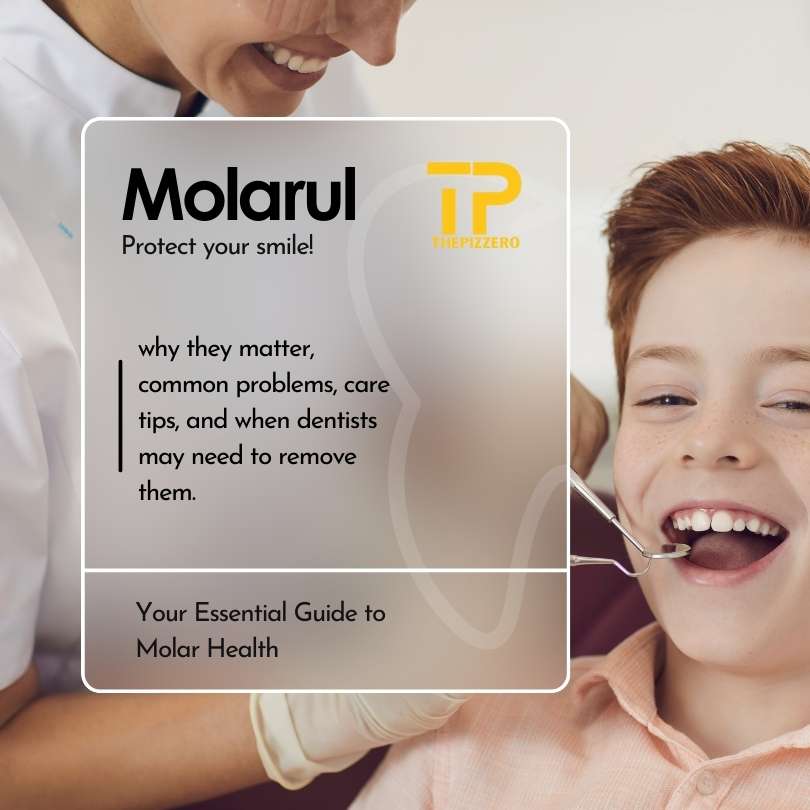Molarul Pain? Your Essential Guide to Molar Health

molarul
That nagging toothache in the back of your mouth? It could be a call for attention from your powerful molars. Let’s uncover the secrets of these workhorse teeth and why they’re crucial to a healthy smile.
In Romanian, we call them ‘molarul’ – the mighty grinders of the mouth. These broad, flat-topped teeth are designed to crush and pulverize food, making them essential for effective digestion.
Taking care of your molars isn’t just about avoiding toothaches. Strong molars directly impact your ability to enjoy a variety of foods, speak clearly, and maintain a confident smile. Plus, their health is interconnected with your overall well-being.
Table Of Contents
Anatomy of a Molarul
Unlike your sharp front teeth (incisors) or your pointy canines, molaruls are built for a completely different task – crushing and grinding your food. Their broad, flat surfaces are covered in cusps, which you can think of like tiny mountain ranges on your teeth. These bumps and grooves work together to pulverize food effectively.
Molars are strategically positioned at the back of your mouth in four sections (quadrants), close to those powerful jaw muscles. Adults typically have three molars in each quadrant, totaling 12 in all. These molaruls aren’t all the same! Your first molars usually emerge around age six, followed by your second molars around age 12. Lastly, we have those sometimes troublesome third molars, known as wisdom teeth, which tend to appear in your late teens or early adulthood.
The Role of Molars in Digestion
Think of your molars as the first stage in your body’s amazing food-processing system! Let’s break down how they kick-start healthy digestion:
- Breaking Down Food: With each bite, your molarul crush and grind food into smaller, more manageable pieces. This isn’t just about comfort; it’s crucial for making food easier to swallow and for exposing more surface area for your digestive enzymes to work on.
- Impact on Nutrition: Imagine trying to eat a whole apple vs. one that’s been sliced or grated. Well-chewed food allows your body to maximize the extraction of vitamins, minerals, and other essential nutrients from everything you eat. Poorly chewed food can hinder nutrient absorption, even if you’re making healthy dietary choices.
Common Molarul Problems and Treatments
Even the most resilient teeth, like your molars, can sometimes develop problems. Here’s a breakdown of the most common issues molarul encounter, along with preventative strategies and how your dentist can provide solutions:
Cavities (Tooth Decay)
The intricate surfaces of molarul, with their pits and grooves, make them more susceptible to trapping food particles and harmful bacteria. This bacteria then produces acid that erodes your tooth enamel. Prevention is crucial, so prioritize meticulous brushing twice a day (especially those back teeth!), daily flossing to reach those tight spaces between molars, and ask your dentist about protective dental sealants. If a cavity does develop, your dentist will remove the decayed portion and restore your tooth with a filling.
Pain and Sensitivity
A toothache in the molarul region demands attention! Discomfort can stem from a variety of causes, including tooth decay, overly worn enamel, exposed tooth roots, habitual clenching or grinding of your teeth (bruxism), or even a fracture. It’s essential to see your dentist, as pain rarely goes away on its own. They will identify the root of the problem and recommend the best course of action, which might include a filling, desensitizing treatment, a custom mouthguard for grinding, or other solutions.
Cracked or Fractured Molars
Whether caused by biting on something hard, an old filling weakening the tooth, an injury, or teeth grinding, a cracked molarul needs professional assessment. Symptoms may include pain when chewing, sensitivity to hot or cold, or sometimes no symptoms at all. The treatment depends on the severity: a minor crack might be fixable with a crown (a cap to protect the tooth), while a deeper fracture may necessitate a root canal or, in severe cases, extraction.
Maintaining Healthy Molarul
Keeping those hardworking molars in top shape isn’t complicated, but consistency is key! Let’s break down the essential practices for protecting your smile:
Optimal Hygiene
- Brush the Back Thoroughly: When brushing, make sure you dedicate enough time to reach the outer, inner, and chewing surfaces of your molarul. Angle the brush bristles slightly to ensure you’re cleaning along the gum line of those back teeth. Remember: two minutes, twice a day!
- Flossing is a Must: Food particles and plaque love to hide in the tight spaces between your molars, where even your toothbrush struggles to reach. Daily flossing is crucial for dislodging these culprits.
- Fluoride Power: Choose a toothpaste with fluoride. This mineral strengthens your tooth enamel, helping it resist decay.
Regular Dental Check-ups
- Cleanings They Can’t Do at Home: Even the most diligent brusher has areas they tend to miss. Your dentist or hygienist has the tools and expertise to remove hardened plaque (tartar) that contributes to gum problems and cavities.
- Catching Problems Early A tiny cavity is a much easier and less expensive fix than a deep one causing major pain. Regular checkups allow your dentist to spot issues while they’re still small and manageable.
- Personalized Advice: Based on an exam, your dentist can tell you whether sealants (protective coatings for molar grooves), fluoride treatments, or other preventive measures might give you extra protection.
Dietary Considerations
- The Sugar Trap: Frequent sugary snacks and drinks provide a constant feast for the bacteria that cause tooth decay. Be mindful of sticky candies that cling to your molarul and acidic beverages that can erode enamel.
- The Crunchy Balance: Crunchy raw fruits and vegetables act as natural cleansers for your teeth. However, be cautious with extremely hard foods like unpopped popcorn kernels or ice, which occasionally can cause a chipped tooth.
Also Read: Natural Blood Thinners: Foods, Herbs & Doctor’s Advice
When Molar Extraction Might Be Necessary
Dentists always aim to preserve your natural teeth whenever possible. However, there are situations where extracting a molarul becomes the best option to protect your oral health and overall well-being. Here are the two most common scenarios:
Impacted Molars
Wisdom teeth are the most frequent culprits, but any molar can become impacted. This means the tooth is unable to erupt properly, remaining partially or completely trapped beneath your gum line. Impacted molarul often cause problems, including:
- Pain & Swelling: The pressure of the trapped tooth can cause discomfort and inflammation in the surrounding gums and jaw.
- Infection Risk: An impacted molar can create pockets where bacteria thrive, increasing the risk of infection.
- Damage to Neighboring Teeth: The misaligned tooth can push against adjacent molars, increasing their risk of cavities or causing them to shift out of place.
- Extraction Process: While sometimes more complex than a typical tooth removal, extractions are performed with appropriate anesthesia or sedation to ensure your comfort. The recovery period may be slightly longer compared to a simple extraction.
Severe Damage
When a molarul is damaged beyond the point where a filling, root canal, or crown can restore it, extraction may be necessary. This can occur due to:
- Extensive Decay: Deep cavities that reach the nerve of the tooth may no longer be treatable with a root canal, leaving extraction as the solution to prevent the spread of infection.
- Fractures Below the Gum Line: Cracks that extend deep below the gum line compromise the tooth’s structural integrity, making it impossible to repair.
- Advanced Gum Disease: In severe cases, the loss of bone support can cause the molar to become loose, necessitating its removal.
- Replacement Options: Your dentist won’t just leave a gap! They’ll discuss ways to replace the missing tooth to restore your chewing ability and the appearance of your smile. Options frequently include dental bridges, implants, or in some cases, partial dentures.
Conclusion
Your molarul, those workhorses at the back of your mouth, play a more significant role in your health than you might realize. They’re crucial for a healthy bite, a confident smile, and the ability to truly enjoy a variety of foods. Unfortunately, problems like cavities, pain, and tooth loss can happen. The good news is, most of these issues are largely preventable!
Proactive care is the key to preserving your molars and overall well-being. By prioritizing thorough brushing, flossing, regular dental check-ups, and smart dietary choices, you give your molaruls the best chance of staying strong for years to come.
If you’re experiencing any toothache in the back of your mouth, or it’s simply been a while since your last dental visit, don’t delay. Schedule an appointment with your dentist. Early treatment is always easier, less invasive, and gives you the peace of mind that comes from knowing your smile is healthy!







